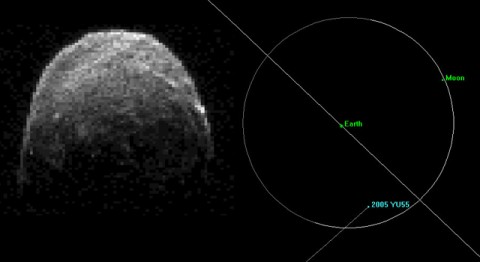Written by DC Agle – Jet Propulsion Laboratory
and Dwayne Brown – NASA Headquarters
 Pasadena, CA – NASA Scientists working with the 230-foot-wide (70-meter) Deep Space Network antenna at Goldstone, CA, have released a second, longer, and more refined, movie clip of asteroid 2005 YU55. The images were generated from data collected at Goldstone on November 7th, 2011, between 11:24am and 1:35pm PST (2:24pm and 4:35pm EST).
Pasadena, CA – NASA Scientists working with the 230-foot-wide (70-meter) Deep Space Network antenna at Goldstone, CA, have released a second, longer, and more refined, movie clip of asteroid 2005 YU55. The images were generated from data collected at Goldstone on November 7th, 2011, between 11:24am and 1:35pm PST (2:24pm and 4:35pm EST).
Each of the 28 frames required 20 minutes of data collection by the Goldstone radar. At the time of the observations, 2005 YU55 was approximately 860,000 miles (1.4 million kilometers) from Earth. The resolution is about 13 feet (4 meters) per pixel. 2005 YU55 takes approximately 18 hours to complete one rotation, so the rotation in the movie appears much more rapid than the actual asteroid rotation speed.

“The encounter with 2005 YU55 has produced an enormous amount of data that is still being processed.” said radar astronomer Lance Benner, the principal investigator for the 2005 YU55 Goldstone observations, from NASA’s Jet Propulsion Laboratory in Pasadena, CA. “The sequence of images we obtained shows unprecedented fine-scale detail on this asteroid, which is comparable in size to the Empire State Building. The Goldstone images show evidence for concavities, a ridge near the asteroid’s equator, and numerous features that may be large boulders.”
The trajectory of asteroid 2005 YU55 is well understood. Although the asteroid is in an orbit that regularly brings it to the vicinity of Earth, (and Venus and Mars), 2005 YU55’s 2011 encounter with Earth was the closest for at least the last 200 years.
[youtube]http://www.youtube.com/watch?v=y1OyUjSBJIE[/youtube]
NASA detects, tracks and characterizes asteroids and comets passing close to Earth using both ground- and space-based telescopes. The Near-Earth Object Observations Program, commonly called “Spaceguard,” discovers these objects, characterizes a subset of them, and plots their orbits to determine if any could be potentially hazardous to our planet.
JPL manages the Near-Earth Object Program Office for NASA’s Science Mission Directorate in Washington. JPL is a division of the California Institute of Technology in Pasadena.
More information about asteroids and near-Earth objects is at: www.jpl.nasa.gov/asteroidwatch and via Twitter at www.twitter.com/asteroidwatch .
More information about asteroid radar research is at: http://echo.jpl.nasa.gov/ .
More information about the Deep Space Network is at: http://deepspace.jpl.nasa.gov/dsn .


